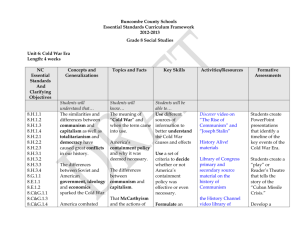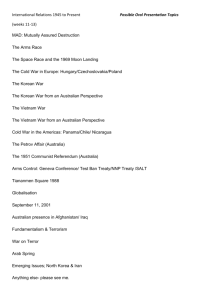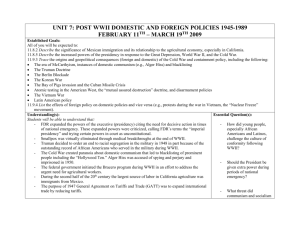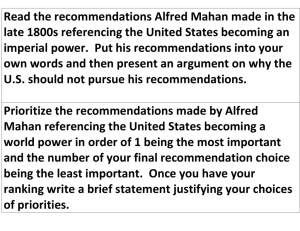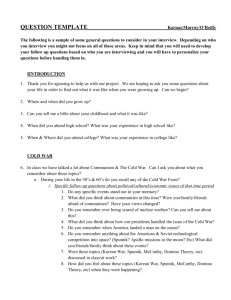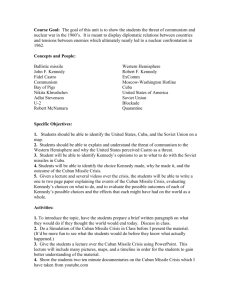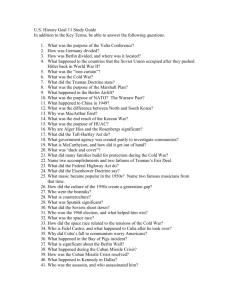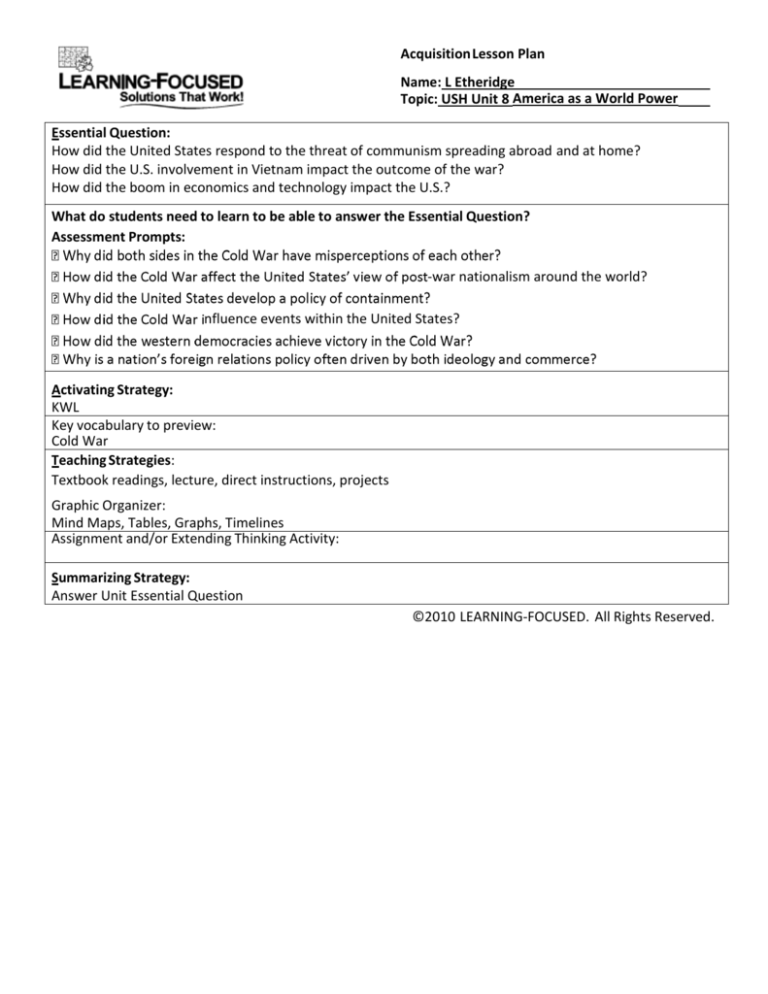
Acquisition Lesson Plan
Name: L Etheridge
Topic: USH Unit 8 America as a World Power
Essential Question:
How did the United States respond to the threat of communism spreading abroad and at home?
How did the U.S. involvement in Vietnam impact the outcome of the war?
How did the boom in economics and technology impact the U.S.?
What do students need to learn to be able to answer the Essential Question?
Assessment Prompts:
-war nationalism around the world?
nfluence events within the United States?
Activating Strategy:
KWL
Key vocabulary to preview:
Cold War
Teaching Strategies:
Textbook readings, lecture, direct instructions, projects
Graphic Organizer:
Mind Maps, Tables, Graphs, Timelines
Assignment and/or Extending Thinking Activity:
Summarizing Strategy:
Answer Unit Essential Question
©2010 LEARNING-FOCUSED. All Rights Reserved.
Acquisition Lesson Pacing Guide
Name: L Etheridge
Topic: USH Unit 8 America as a World Power
Essential Question: How did the United States respond to the threat of communism spreading abroad and at
home? How did the U.S. involvement in Vietnam impact the outcome of the war? How did the boom in
economics and technology impact the U.S.?
Day 62/Session 1
Day 63/Session 2
Day 64/Session 3
Activating Strategy:
Daily 10
Activating Strategy:
Daily 10
Antiwar political cartoon
Activating Strategy:
Daily 10
Video clip of space launch
Key Vocabulary and Strategy
Students copy and define in the
vocabulary section of their
notebook by folding paper in half
with one side having definition
and other the term/phrase
Key Vocabulary and Strategy:
Students copy and define in the
vocabulary section of their
notebook by folding paper in half
with one side having definition
and other the term/phrase
Key Vocabulary and Strategy:
Cold War, Marshall Plan, Truman
Doctrine, Eisenhower Doctrine,
Containment Policy, Communism,
Joseph McCarthy, McCarthyism,
Fidel Castro, Cuban Revolution,
Bay of Pigs, Cuban Missile Crisis
Domino Effect, Tet Offensive,
Vietcong, Ho Chi Minh, Baby
Boom, Levittown, Interstate
Highway Act, Personal Computer
Teaching Strategies:
Teaching Strategies:
Teaching Strategies:
Read Chapter 30 for
homework
Read pages 209-213 in
workbook together
Read pages 198-199 in
textbook and complete fill in
the blank questions
students use reading and
wordbook to answer questions
1-11 on page 215-6
Read page 199-201 together in
EOCT and answer prompts.
Summarize reading on
whiteboard to be copied into
notes section of notebook.
Copy and answer questions 13 on page 201 in workbook
Read pages 204-205 in
workbook on space race
Copy and answer SSUSH21d in
notebook
Read pages 206-208 in
workbook
Debrief reading
Answer question 1-2 on page
213-4
Read Chapter 26 for
homework
Discussion of the Marshal Plan
and the Truman Doctrine
Thinking Map (Bubble, Tree or
Circle) for containment
policies
Chart of NATO and Warsaw
Pact Countries
Create colored map of NATO
and Warsaw Pact Countries
Read pages 195-198 in
workbook
Summarize on whiteboard
together
Read Dr. Seuss The Butter
Battle book (represents the
Cold War)
Carousel brainstorming
activity to summarize reading
Review for test
o I have, Who has
vocabulary activity
Assessment Prompt
Why did both sides in the Cold
War have misperceptions of each
other?
How did the Cold War affect the
United States’ view of post-war
nationalism around the world?
Assessment Prompt
Why is a nation’s foreign relations
policy often driven by both
ideology and commerce?
How was the Vietnam War
received in the US?
Assessment Prompt
Why is a nation’s foreign relations
policy often driven by both
ideology and commerce?
Summarizing Strategy:
Answer standard
Complete questions after
reading
Summarizing Strategy:
Carousel Brainstorming
Why did the United States develop
a policy of containment?
Summarizing Strategy:
Understanding Check
Day 64/Session 3
Activating Strategy:
Unit Test
Key Vocabulary and Strategy:
Cold War, Marshall Plan,
Truman Doctrine, Eisenhower
Doctrine, Containment Policy,
Communism, Joseph McCarthy,
McCarthyism, Fidel Castro,
Cuban Revolution, Bay of Pigs,
Cuban Missile Crisis, Domino
Effect, Tet Offensive, Vietcong,
Ho Chi Minh, Baby Boom,
Levittown, Interstate Highway
Act, Personal Computer
Teaching Strategies:
Review for test
Unit Test
Summarizing Strategy:
Unit Test
©2010 LEARNING-FOCUSED. All Rights Reserved.
Know-Understand-Do Organizer
Key Learning and Unit Essential Question(s)
Key Learning(s):
The United States emerged from WWII with a fear of communism which led to conflicts abroad, technological
growth and an economic boom
Unit Essential Question(s):
How did the end of WWII and the Cold War impact the U.S.?
Standards/GLEs
SSUSH20 The student will analyze the domestic and international impact of the Cold War on the United
States.
a. Describe the creation of the Marshall Plan, U.S. commitment to Europe, the Truman Doctrine, and the origins
and implications of the containment policy.
b. Explain the impact of the new communist regime in China and the outbreak of the Korean War and how
these events contributed to the rise of Senator Joseph McCarthy.
c. Describe the Cuban Revolution, the Bay of Pigs, and the Cuban Missile Crisis.
d. Describe the Vietnam War, the Tet Offensive, and growing opposition to the war.
e. Explain the role of geography on the U.S. containment policy, the Korean War, the Bay of Pigs, the Cuban
Missile Crisis, and the Vietnam War.
SSUSH 21 The student will explain the impact of technological development and economic growth and its
impact on the United States, 1945-1975.
d. Describe the impact of competition with the USSR as evidenced by the launch of
Sputnik I and President Eisenhower’s actions.
KNOW
Policies the United States used to
deal with Communism including:
Marshall Plan, Truman Doctrine,
Eisenhower Doctrine, Domino
Effect the containment policy.
Effect of Communism on politics
and society
Cuban/American relations
Reasons for Cuban Missile Crisis
Course of the Vietnam War
Geography of Communists
countries in relation to U.S.
interests
Impact of television on society’s
view of politics and war
Effects of economic prosperity in
the 1950s
Effects of technology on the U.S.
society
UNDERSTAND
Understand the impact of the Cold
War on U.S. society
Understand fear of communism in
the U.S.
Understand the relationship
between the U.S. and the USSR
Understand the impact of
technology and economic growth in
the U.S. from 1945-1975
DO
- Describe the creation of the
Marshall Plan, Truman Doctrine,
Containment Policy and Domino
Effect
- Explain the concerns about
communism in the United States
in regards to the Korean War and
McCarthyism
- Describe the rise of communism
in Cuba, the overthrow by Fidel
Castro and the failed Bay of Pigs
attempt
- Describe the Cuban Missile Crisis
and the role of the Soviet Union
and Kennedy
- Describe the role of the U.S. in
the Vietnam War and the Vietcong
counterforce of Ho Chi Minh and
the Tet Offensive
- Explain how American society
reacted to U.S. involvement in the
war including the use of television
Causes and effects of the Space
Race between U.S. and USSR
The vocabulary for Unit 9 (see
SLM)
- Explain the importance of
geography in the U.S. policies
regarding communism
- Describe boom of the 1940s and
1950s in regards to the increase in
population, Levittown, and the
Interstate Highway Act
- Describe the impact of television
on the Civil Rights Movement and
Kennedy/Nixon debates
- Analyze the impact of technology
on American life including the
development of the personal
computer and expanded use of air
conditioning
- Describe the Space Race between
the U.S. and the USSR, include
Sputnik I and President
Eisenhower’s response
Launch:
- Show first space launches
- Show a clip from MASH
- Anti-War songs
- Ballad of The Green Beret (song)
Formative Assessments:
- Thinking Map (Bubble, Tree or Circle) for containment policies
- Matching activity with containment policies
- Letter to the House Un-American Activities Committee support their efforts
- Map of communist countries
- Writing prompt about gains from Space Race
- Analyze journals of Vietnam soldiers
- Vietnam War Timeline
- Response to news program about war
- Writing prompt about the importance of technology advances of the time
- Have students watch a portion of the Kennedy/Nixon Debate and write a response to the candidate that
they found most appealing
- Take a stand poster activity (either support the war or Anti war)
- Analyze primary sources
Summative Assessment:
- Vocabulary Quiz, Map, or Review Quizzes
- Multiple Choice Exam (reflective of U.S. History EOCT) with short answer/essay options
Additional Resources:
- Origins of the Cold War resources: http://www.tahg.org/module_display.php?mod_id=16&review=yes
- Cold War resources: http://www.tahg.org/module_display.php?mod_id=109&review=yes
- Korean War resources: http://www.tahg.org/module_display.php?mod_id=184&review=yes
- Eisenhower and Kennedy resources: http://www.tahg.org/module_display.php?mod_id=82&review=yes
- Red Scare resources: http://www.tahg.org/module_display.php?mod_id=108&review=yes
- We didn’t start the fire video: http://www.teacheroz.com/fire.htm
-
Jeopardy Review: http://www.jeopardylabs.com/play/unit-15-jeopardy-review
Presidential Campaign resources: http://www.livingroomcandidate.org/
Presidential Recordings: http://whitehousetapes.net/content/classroom/index.php?n=Main.Topics
Jeopardy Review too: http://www.jeopardylabs.com/play/unit-15-review-2
http://www.coldwar.org/
http://www.cubanmissilecrisis.org/
http://www.jfklibrary.org/JFK/JFK-in-History/Cuban-Missile-Crisis.aspx
http://www.funfront.net/hist/europe/coldwar.htm
http://www.history.com/topics/cold-war
http://www.thepeoplehistory.com/1990s.html
http://content.lib.washington.edu/protestsweb/index.html
http://www.war-stories.com/research-poss-student.asp
http://www.loc.gov/vets/youth-resources.html
http://www.history-timelines.org.uk/events-timelines/06-vietnam-war-timeline.htm
Name: L. Etheridge
Course/Subject: U.S. History/ Social Studies
Topic: America as a World Power
School: Glynn Academy
School District: Glynn County
Key Learning: The United States emerged from WWII with a fear of communism which led to conflicts abroad,
technological growth and an economic boom.
Unit Essential Question: How did the end of WWII and the Cold War impact
the U.S.?
Concept: The Cold War
Concept: Communism
Concept: Vietnam War
Concept: Technology and
Economic Boom
Lesson Essential
Questions:
How did the United
States respond to the
threat of communism
spreading abroad?
Lesson Essential
Questions:
How did the U.S.
respond to the threat
of communism at
home?
Lesson Essential
Questions:
How did the U.S.
involvement in
Vietnam impact the
outcome of the war?
Lesson Essential
Questions:
How did the boom in
economics and
technology impact the
U.S.?
Vocabulary:
Cold War
Marshall Plan
Truman Doctrine
Eisenhower Doctrine
Containment Policy
Vocabulary:
Communism
Joseph McCarthy
McCarthyism
Fidel Castro
Cuban Revolution
Bay of Pigs
Cuban Missile Crisis
Vocabulary:
Domino Effect
Tet Offensive
Vietcong
Ho Chi Minh
Vocabulary:
Baby Boom
Levittown
Interstate Highway
Act
Personal Computer
Cold War
Marshall Plan
Marshall Plan
Truman Doctrine
Truman Doctrine
Eisenhower Doctrine
Eisenhower Doctrine
Containment Policy
Containment Policy
Communism
Communism
Joseph McCarthy
Joseph McCarthy
McCarthyism
McCarthyism
Fidel Castro
Fidel Castro
Cuban Revolution
Cuban Revolution
Bay of Pigs
Bay of Pigs
Cuban Missile Crisis
Cuban Missile Crisis
Domino Effect
Domino Effect
Tet Offensive
Tet Offensive
Vietcong
Vietcong
Ho Chi Minh
Ho Chi Minh
Baby Boom
Baby Boom
Levittown
Levittown
Interstate Highway Act
Interstate Highway Act
Personal Computer
Personal Computer
Iron Curtain
Iron Curtain
Berlin Airlift
Berlin Airlift
Mao Tse-tung
Mao Tse-tung
Korean War
Korean War
2nd Red Scare
2nd Red Scare
House Un-American Activities Committee (HUAC)
House Un-American Activities Committee (HUAC)
Sputnik
Sputnik
space race
space race
Fidel Castro
Fidel Castro
Berlin Wall
Berlin Wall
Vietnam
Vietnam
Gulf of Tonkin Resolution
Gulf of Tonkin Resolution
Cold War

